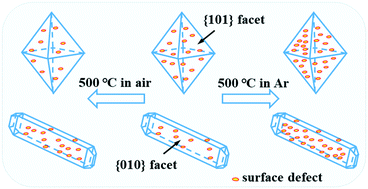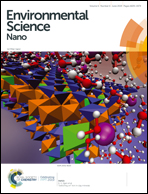Facet-dependent evolution of surface defects in anatase TiO2 by thermal treatment: implications for environmental applications of photocatalysis†
Abstract
Thermal treatment is one of the most common and facile approaches for defect engineering of semiconductor nanomaterials for enhanced photocatalytic activities. Thus far, little is known about how exposed facets, an intrinsic nanomaterial property, may affect defect generation of widely used semiconductor nanomaterials, e.g., titanium dioxide (TiO2). Here, we synthesized two anatase TiO2 materials with different predominantly exposed facets (i.e., {101} and {010} facets, respectively), and manipulated the defects by calcination at 500 °C under an air or argon atmosphere. Through Raman, electron paramagnetic resonance, UV-vis, and X-ray photoelectron spectroscopy analyses, we demonstrated that the change of surface defect content was facet-dependent. Calcination in argon consistently increased the surface defect content for both materials, arising from the dissociation of surface oxygen atoms and removal of surface hydroxyl groups. In comparison, calcination in air decreased the surface defect content of the {101}-faceted material but increased that of the {010}-faceted material. This discrepancy was likely because, compared with the {101} facets, the {010} facets can lose surface oxygen more easily and contain a greater amount of surface hydroxyl groups. Accordingly, for the {010} facets the formation of surface defects can outcompete the annealing of defects, which occurs during thermal treatment in air. Photoluminescence analysis, electrochemical impedance spectroscopy and photocatalytic activities towards bisphenol A, Rhodamine B and hexavalent chromium degradation were consistent with the changes of defect content of the TiO2 materials, corroborating that the altered defect properties were mainly associated with surface rather than bulk defects. The findings of this work may have important implications for photocatalyst design via defect engineering.

- This article is part of the themed collections: Nanomaterials in air and Nanomaterial applications in water


 Please wait while we load your content...
Please wait while we load your content...